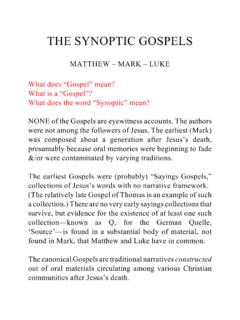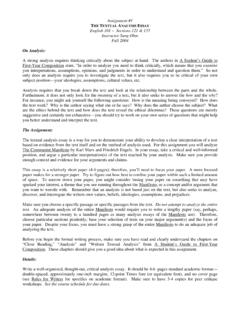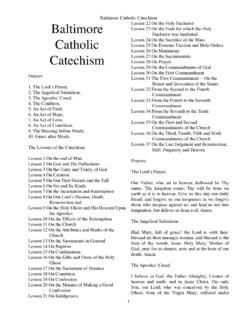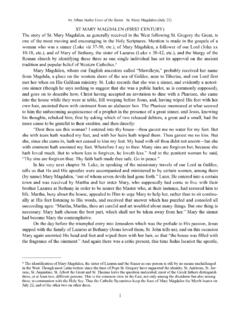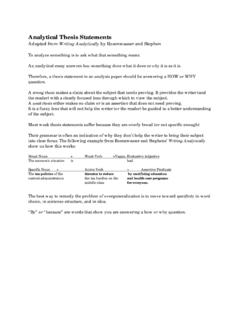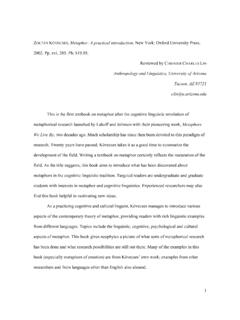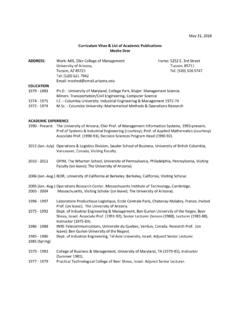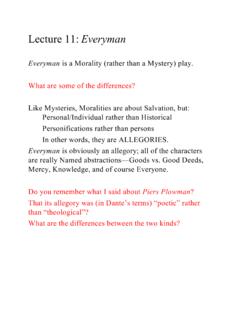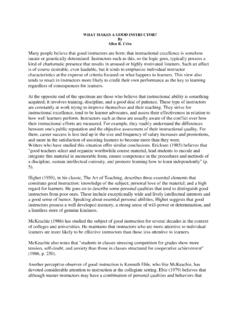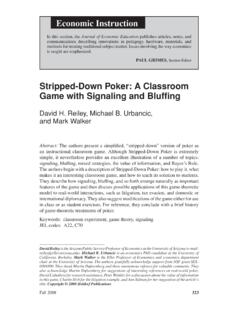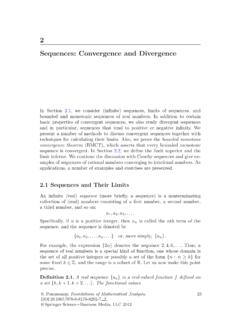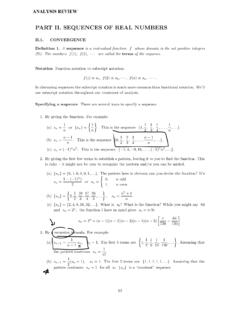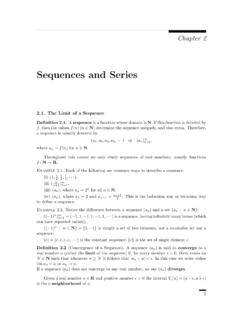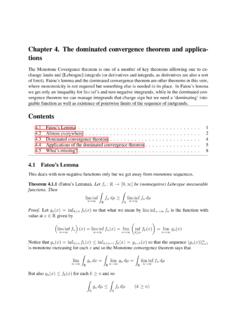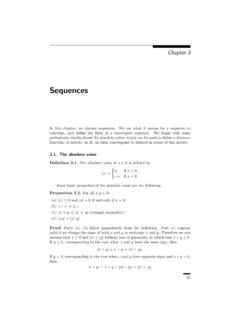Transcription of Cauchy Sequences and Complete Metric Spaces
1 Cauchy Sequences and Complete Metric SpacesLet s first consider two examples of convergent Sequences inR:Example 1:Letxn=1n 2 for eachn N. Note that eachxnis an irrational number ( ,xn Qc) and that{xn}converges to 0. Thus,{xn}converges inR( , to an element ofR). But0 is a rational number (thus, 06 Qc), so although the sequence {xn}is entirely inQc, it does notconverge inQc, in spite of being well-behaved in the sense that it converges 2:Letx1 N, and letxnbe the sequence defined byxn+1=12xn+1xnfor eachn can show that the sequence {xn}converges to 2. (You ll be asked to do that in an exercisebelow.)
2 Then{xn}is a sequence of rational numbers that converges to the irrational number 2 , eachxnis inQand lim{xn}= 26 Q. Thus, in a parallel to Example 1,{xn}hereconverges inRbut does not converge 1 and 2 demonstrate that both the setQcof irrational numbers and the setQofrational numbers are not entirely well-behaved Metric Spaces : there are well-behaved Sequences ineach space that don t converge to an element of the space. The Sequences are well-behaved in thesense that they do converge inR. The following definition formalizes this idea of a well-behavedsequence in a Metric space (such asQandQc), but without requiring any reference to some other,larger Metric space (such asR).
3 Definition:A sequence {xn}in a Metric space (X,d) isCauchyif >0 : n N:m,n >n d(xm,xn)< .Remark:Convergent Sequences are :Let{xn} x, let >0, letnbe such thatn >n d(xn,x)< /2, and letm,n >n. Thend(xm,x)< 2andd(xn,x)< 2,and the Triangle Inequality yieldsd(xm,xn)5d(xm,x) +d(xn,x)< 2+ 2= . Exercise:The real sequence {xn}defined byxn=1nconverges, so it s Cauchy . Prove directlythat it s Cauchy , by showing how thenin the definition depends upon .Definition:A Metric space (X,d) iscompleteif every Cauchy sequence inXconverges inX( , to a limit that s inX).Example 3:The real interval (0,1) with the usual Metric is not a Complete space: the sequencexn=1nis Cauchy but does not converge to an element of (0,1).
4 Example 4:The spaceRnwith the usual (Euclidean) Metric is Complete . We haven t shown thisyet, but we ll do so 1:Every Cauchy sequence in a Metric space is 2:If a Cauchy sequence has a subsequence that converges tox, then the sequenceconverges order to prove thatRis a Complete Metric space, we ll make use of the following result:Proposition:Every sequence of real numbers has a monotone :Suppose the sequence {xn}has no monotone increasing subsequence; we show that thenit must have a monotone decreasing subsequence. The sequence {xn}must have a first term, sayxn1, such that all subsequent terms are at least as small ( ,n > n1 xn5xn1); otherwise{xn}would have a monotone increasing subsequence.
5 Similarly, the subsequence{xn1+1,xn1+2,..}must have a first termxn2such that all subsequent terms are at least as small; note thatxn1= forn1,n2,n3,.., we have a subsequence{xnk}such thatxn1=xn2=xn3=.., amonotone decreasing subsequence. Now we ll prove thatRis a Complete Metric space, and then use that fact to prove that theEuclidean spaceRnis :Ris a Complete Metric space , every Cauchy sequence of real numbers :Let{xn}be a Cauchy sequence . Remark 1 ensures that the sequence is bounded, andtherefore that every subsequence is bounded. The proposition we just proved ensures that thesequence has a monotone subsequence.
6 The monotone convergence Theorem ensures that thisbounded monotone subsequence converges. And therefore Remark 2 ensures that the originalsequence converges. This proof used the Completeness Axiom of the real numbers thatRhas the LUB Property via the monotone convergence Theorem. We could have gone instead in the other direction:taking every Cauchy sequence of real numbers converges to be the Completeness Axiom, andthen proving thatRhas the LUB :The normed vector spaceRnis a Complete Metric 5:The closed unit interval [0,1] is a Complete Metric space (under the absolute-valuemetric).
7 This is easy to prove, using the fact thatRis 6:The spaceC[0,1] is Complete . (We haven t shown this yet.)Exercise:In a previous exercise set we worked with a sequence of distribution functionsFndefinedbyFn(x) ={nx,ifx51n1,ifx= the unit interval [0,1] inR. We showed that{Fn}does not converge inC[0,1]. Therefore, if{Fn}were Cauchy ,C[0,1] would not be Complete . Verify that{Fn} 7:(ObtainingRas the completion ofQ.)LetSbe the set of Cauchy Sequences inQ , the set of Cauchy Sequences of rational numbers with the usual Metric . Define a relation onSas follows:{xn} {x n}if >0 : n N:m,n > n d(xm,x n)< LetQ =S/ , the partition ofSconsisting of equivalence classes of Cauchy Sequences .}
8 Definethe distance functiond forQ as follows:For anyx,x Q , let{xn} xand{x n} x ( ,x= [{xn}] andx = [{x n}]).Then defined (x,x ) byd (x,x ) = limn d(xn,x n).It s pretty straightforward to show thatd is well-defined and is a Metric forQ . The metricspace (Q ,d ) can be placed into one-to-one correspondence with (R,| |), each constant sequence {r,r,r,..}of rationals corresponding to the rational numberr Q R. The setQ is one wayof :Verify that the relation defined in Example 7 is an equivalence 8:(The Completion of a Metric Space)Let (X,d) be a Metric space that is not Complete .
9 Just as in Example 7, letSbe the set of Cauchysequences inX; define the equivalence relation in the same way, and letX be the quotientspaceS/ ; and defined on the quotient spaceX in the same way as in Example 7. Then wecan show, just as in Example 7, thatd is well-defined and is a Metric forX ; that (X ,d ) is acomplete Metric space; and thatXcorresponds to a subset ofX we say thatXis embeddedinX . The Complete Metric space (X ,d ) is called thecompletionof (X,d).3 Example 9:The open unit interval (0,1) inR, with the usual Metric , is an incomplete metricspace. What is its completion, ((0,1) ,d ))?
10 Theorem:A subset of a Complete Metric space is itself a Complete Metric space if and only if itis that every normed vector space is a Metric space, with the metricd(x,x ) = x x .Therefore our definition of a Complete Metric space applies to normed vector Spaces : an iscomplete if it s Complete as a Metric space, , if all Cauchy Sequences converge to elements ofthe :A Complete normed vector space is called aBanach 4 revisited:Rnwith the Euclidean norm is a Banach 5 revisited:The unit interval [0,1] is a Complete Metric space, but it s not a Banachspace because it s not a vector 6 revisited:C[0,1] is a Banach :Letaandx1be positive real numbers, and let{xn}be the sequence defined byxn+1=12xn+a2xnfor eachn N.
